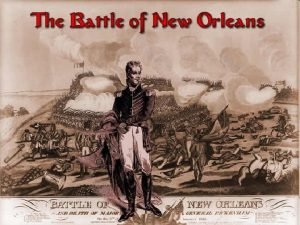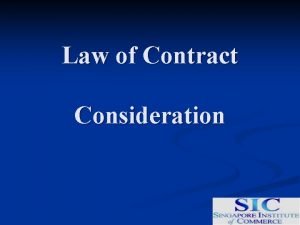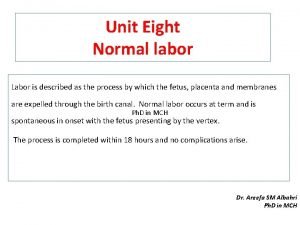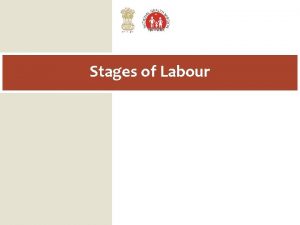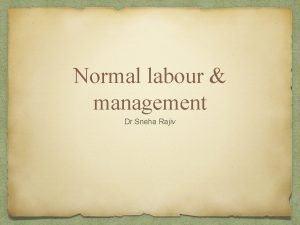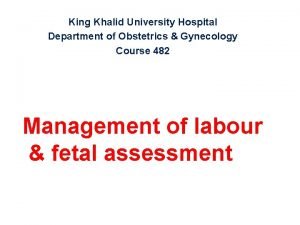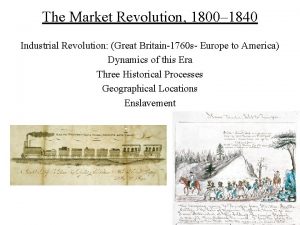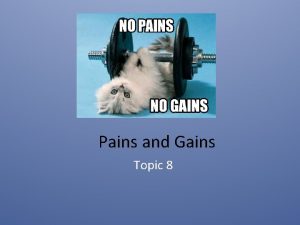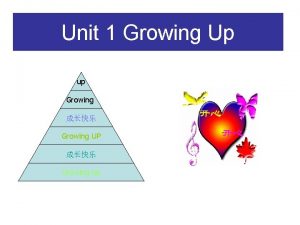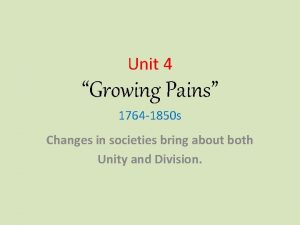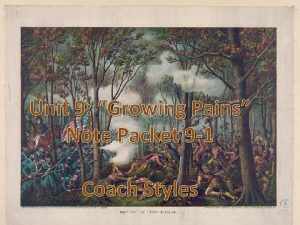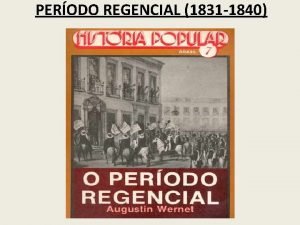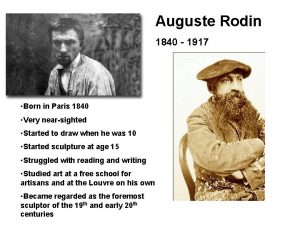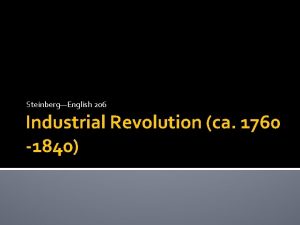Unit 7 Growing Pains Gains Industrial Revolution 1840


















- Slides: 18

Unit 7: Growing Pains & Gains Industrial Revolution 1840 – 1920 Was the rise of industry good for the United States?

Goals 1. Describe the factors that allowed the Industrial Revolution to occur in the U. S. 2. Understand the pros/cons of the Industrial Revolution. 3. Understand how laborers responded to issues that arose during the Industrial Revolution. 4. Connect immigration policies during the Industrial Revolution to immigration policies today. 5. Identify how segregation still exists today.

Targets 1. What were the factors that enabled the U. S. to become an industrial power? 2. What were some of the different responses of labor to industrialism? 3. How did industrialism change where people lived? What issues arose from this? Do we still see these issues today?

Warm-Up • Think about this question: What are three most important innovations, or inventions, of your lifetime?

Photo Analysis • What’s your overall impression of the photo? • What details do you see? • 3 columns People Objects Activities


Fair Labor Standards Act of 1938 • Minimum wage • Working day/overtime pay • Most importantly… – Child labor laws Law today: http: //www. dol. gov/whd/childlabor. htm

How/why did the Industrial Revolution happen? 1. Economics – Supply/Demand • As people start earning a steady wage, demand for products goes up and so to keep up companies increase supply – What does increased demand lead to? • Innovation technology – What were some advances in technology during this time? 2. Rise of oil – Edwin Drake hits oil in Pennsylvania in 1859. 3. Rise of steel – Henry Bessemer developed new method of making steel that was cheaper/quicker

How/why did the Industrial Revolution happen? 4. Assembly line further developed by Henry Ford in early 1900 s 5. Government policy – What was it during this time? • • Laissez-faire What’s this mean? Social Darwinism what’s this mean? – What did the government actually do? • Helped big business… – How? » Gave land away to RR companies » Sold natural resources to companies @ cheap prices » Tariffs on foreign goods

What influence did the government have? • • Formation of Corporations – What’s the significance? • How does this affect small business? – Monopolies form • What’s a monopoly? – Why is this an issue? – Think about the game… company that gains complete control of a market… they then can set whatever price they want… – Trusts • What are trusts? – Small group of companies that are involved in the same market (like automobiles) that agree to set prices together. This limits the ability of the consumer to shop for the best product at the best price. How did these corporations become so large/powerful? – Vertical integration (Carnegie – Steel) • Taking over all of the steps of production (buy out companies that you have to buy from to complete your product so that you can reduce costs) – Horizontal integration (Rockefeller - Oil) • Taking over any company that makes your product or a similar product to cut out competition

What were some consequences? • Pollution • Child labor • Tenement living what was this? – Small living quarters, pack many individuals into one apartment… lucky if have running water • Rise of middle class • Rise of urbanization • Increased social stratification • Women enter work force • Rise of labor unions • Increased regulation of market

City Conditions • Dr. Southwood-Smith – “Uncovered sewers, stagnant ditches and ponds, gutters always full of putrefying matter… it is not possible for any language to convey an adequate conception of the poisonous condition in which large portions of both these districts always remain… from the masses of putrefying matter which are allowed to accumulate. ” • (sign me up for a post honeymoon trip!)

Labor Unions Union Knights of Labor American Federation of Labor Industrial Workers of the World Goals Members Strategies

Labor Unions Union Goals Knights of Labor • 8 hr day • No child labor • Regulation of trusts • = pay men/women • Educate working class American Federation of Labor Members • Skilled/unskilled workers • Women • African Americans Strategies • Arbitration • Boycotts • Strikes • Increased wages • Skilled workers of • Negotiation • Improved work particular trade • Boycotts conditions • Strikes • Limitation of work hrs • Recognition of union Industrial Workers of • Organization of the World all workers into • Lumberman • Miners • Boycotts • Strikes

Early Strikes Strike Railroad Strike of 1877 Homestead Strike Pullman Strike Reason for Strike • Workers sought out increased wages Outcome • Strike shut down ½ nation’s RR • President Hayes sent in army to squash strike

Early Strikes Strike Who was Striking Outcome Railroad Strike of 1877 • Workers sought out increased wages • Strike shut down ½ nation’s RR • President Hayes sent in army to squash strike Homestead Strike of 1892 • Iron & steel workers • Carnegie sent guards • Strikers angered fought w/guards • 9 strikers dead • Nonunion workers hired Pullman Strike of 1894 • Pullman Palace Car Company employees • Workers struck against company b/c unfair policies in company town • American Railway Union supported strike & shutdown railways • President Cleveland sent in army to squash strike

Sherman Anti-Trust Act of 1890 • Trusts, monopolies, & other forms of business that restrict trade are illegal – Now examined by the Federal Trade Commission

Recap • If you were alive during the U. S. Industrial Revolution, what would you most likely be doing right now? When would you have started this? • Describe city life. • Describe factory conditions. Was the rise of industry good for the United States?
 Growing pains for the new nation
Growing pains for the new nation Do growing pains exist
Do growing pains exist Growing pains for the new nation
Growing pains for the new nation They ran through the brambles
They ran through the brambles Segundo reinado 1840 a 1889
Segundo reinado 1840 a 1889 England v davidson (1840)
England v davidson (1840) Bunyi hukum minimum liebig
Bunyi hukum minimum liebig Segundo reinado 1840 a 1889
Segundo reinado 1840 a 1889 Fue descubierto y nombrado por schoenbein en 1840
Fue descubierto y nombrado por schoenbein en 1840 Claude monet 1840 1926
Claude monet 1840 1926 True labour pain
True labour pain True labour pain
True labour pain True labor pains
True labor pains True labour pains
True labour pains Breast abscess treatment
Breast abscess treatment True labour pain definition
True labour pain definition Pains wessex epirb battery replacement
Pains wessex epirb battery replacement Early period symptoms
Early period symptoms Unit 1 growing up
Unit 1 growing up



